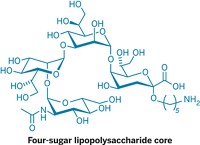Advertisement
Grab your lab coat. Let's get started
Welcome!
Welcome!
Create an account below to get 6 C&EN articles per month, receive newsletters and more - all free.
It seems this is your first time logging in online. Please enter the following information to continue.
As an ACS member you automatically get access to this site. All we need is few more details to create your reading experience.
Not you? Sign in with a different account.
Not you? Sign in with a different account.
ERROR 1
ERROR 1
ERROR 2
ERROR 2
ERROR 2
ERROR 2
ERROR 2
Password and Confirm password must match.
If you have an ACS member number, please enter it here so we can link this account to your membership. (optional)
ERROR 2
ACS values your privacy. By submitting your information, you are gaining access to C&EN and subscribing to our weekly newsletter. We use the information you provide to make your reading experience better, and we will never sell your data to third party members.
Biological Chemistry
Lab-Made Sugars Aid Diagnosis
Infectious Disease: Synthetic oligosaccharides could solve long-standing brucellosis detection problem
by Stu Borman
October 10, 2014
| A version of this story appeared in
Volume 92, Issue 41
A new oligosaccharide synthesis could lead to more reliable diagnoses of the bacterial disease brucellosis, which afflicts animals and people worldwide.
When cattle are infected with Brucella bacteria, infection can spread rapidly within herds, where it causes abortion, births of weak calves, and reduced milk yields. In people, who can catch brucellosis from unpasteurized dairy products or contaminated meat, symptoms include excessive sweating and joint and muscle pain, and the condition can be chronic or even lifelong.
Brucellosis is typically diagnosed by detecting antibodies the body produces to fight the bacteria. But the Brucella cell-wall molecule contains two oligosaccharide antigens, A and M; other bacteria carry the same A antigen; and antibodies to A and M cannot currently be detected independently. So brucellosis diagnostic tests often give false-positive results, which complicate human treatment and cause commercial animal herds to be declared disease-tainted when they’re not.

Now, David Bundle of the University of Alberta; John McGiven of the Animal & Plant Health Agency, in Surrey, England; and coworkers have synthesized several versions of Brucella antigens and have conjugated them to carrier proteins (J. Am. Chem. Soc. 2014, DOI: 10.1021/ja5081184). The conjugates can bind and detect A and M antibodies independently. The researchers suggest that the disaccharide M-antigen conjugate could be used to unambiguously detect the immune response to brucellosis infection in humans and animals.
“We have established collaborations to evaluate the synthetic antigens for diagnosis,” Bundle says.
Brucellosis expert Jacques Godfroid of the University of Tromsø—the Arctic University of Norway, says, “For the brucellosis scientific community and all those fighting brucellosis—farmers, veterinary services, and food safety and veterinary public health scientists—this work represents the first major breakthrough in decades toward avoiding false-positive serological reactions in brucellosis testing. A test would have to go through validation steps, but for the first time in decades there is something extremely promising.”





Join the conversation
Contact the reporter
Submit a Letter to the Editor for publication
Engage with us on Twitter